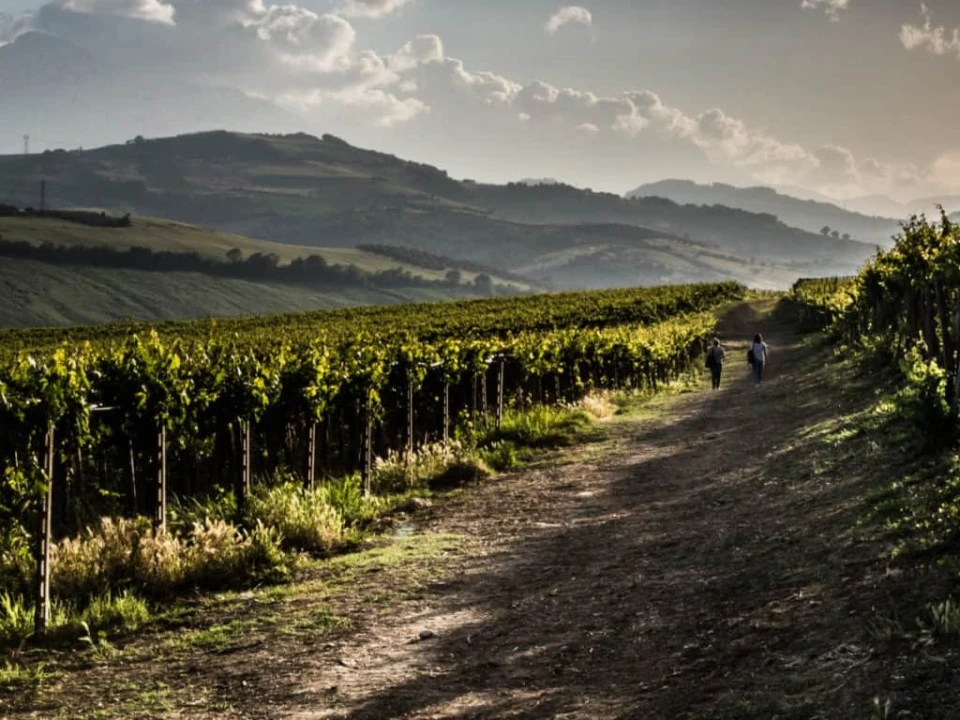The total vineyard area in Abruzzo exceeds 32,000 hectares, with nearly 96% of it located on hills and 4% dedicated to mountain viticulture. The total wine production exceeds 2.6 million hectoliters, of which 38% are DOP wines, 15% IGP wines, 30% red and rosé wines, and 70% white wines. The vineyard area of Abruzzo is made up of 32,000 hectares, with 4% in the mountains and 96% in the hills.
The history of viticulture in Abruzzo dates back to the Roman era, and since then, Abruzzo wines have been mentioned in the writings of authors from every era, starting with Polybius, who referenced the wines while narrating Hannibal’s actions during the Battle of Cannae (216 BC).
In 1596, Andrea Bacci in his work De naturali vinorum historia de vinis Italiae spoke about the wines of Sulmona and the Peligni region, while in 1792, Michele Torcia described the presence of the Montepulciano grape in Abruzzo for the first time. From the 1800s onward, there have been numerous references to Montepulciano, which became the symbol of this region from the early 1900s.
Among the Abruzzo wine denominations, the most famous is the Montepulciano d’Abruzzo Colline Teramane DOCG, whose wine must undergo one year of maturation in wood before being released to the market, compared to the Montepulciano d’Abruzzo DOC. From Montepulciano, the Cerasuolo d’Abruzzo DOC rosé is also produced, a fruity, fresh, soft, well-bodied wine that pairs well with all dishes.
Other DOCs in the region include Trebbiano d’Abruzzo DOC, Controguerra DOC (with its various types of products, ranging from passito to sparkling wine, using either indigenous or international grape varieties, focusing on the territorial nature of the product as it is confined to just five municipalities). Recently, an additional denomination, Abruzzo DOC, was introduced, encompassing all the indigenous grape varieties of the region, including in sparkling and passito styles.
Abruzzo has two DOCG designations: the already mentioned Montepulciano d’Abruzzo Colline Teramane DOCG and the Terre Tollesi or Tullum DOCG, created in 2019 from the existing DOC, along with seven DOCs and eight IGTs.
From a viticulture perspective, Abruzzo can be divided into two distinct zones: the first is the Teramano region, and the second includes the areas of Pescara and Chieti.
In the first zone, heading south from the north of the province of Teramo, lies the historic area of Montepulciano, represented by the DOCG Montepulciano d’Abruzzo Colline Teramane, where Montepulciano can be blended with a maximum of 10% Sangiovese. The wine must be aged for a minimum of one year, and three years for the Riserva version. Montepulciano (minimum 70%) forms the basis for red, rosé, novello, and passito wines. The white wines, still, passito, and sparkling, are based on the Trebbiano grape, which is widely cultivated throughout the region. The varietal wines from this denomination use both indigenous varieties, such as Pecorino and Passerina, and international ones, such as Cabernet, Merlot, and Chardonnay.
The Montepulciano d’Abruzzo DOC and Trebbiano d’Abruzzo DOC designations cover almost the entire region, excluding the mountainous internal areas of the Gran Sasso, Velino, and Majella mountain ranges, which reach altitudes close to 3,000 meters. These two denominations are reserved for varietal wines made from the respective grape varieties, including in the superiore and riserva types. Montepulciano is also the base for one of Italy's most famous rosé wines, Cerasuolo d’Abruzzo DOC, produced in the same DOC area as Montepulciano and appreciated for its delicacy and structure.
Regarding the second zone, the province of Pescara produces Montepulciano, including in the Riserva type, in the two subzones of the DOC Montepulciano d’Abruzzo, Terre dei Vestini and Casauria. In the same areas, under the DOC Trebbiano d’Abruzzo, Trebbiano also reaches the highest levels of excellence, with base, superiore, and riserva types. The Terre dei Peligni and Alto Tirino subzones are located in the province of L'Aquila, with vineyards located in foothill areas at the foot of some of central Italy's highest mountain ranges. The Teate subzone is in the province of Chieti, which is also home to the region's second, very recent DOCG, Terre Tollesi or Tullum. The denomination surrounds Tollo, a small hilltop town 5 km from the Adriatic coast. It includes four types of wine: two whites, based on indigenous grape varieties Passerina and Pecorino, two reds, the base and riserva versions, both based on Montepulciano, and a white sparkling wine made from Chardonnay (minimum 60%).
The province of Chieti is the most important viticulturally, as it accounts for over 80% of the region's production. In addition to the already mentioned Terre Tollesi or Tullum DOCG, it is home to the DOC Ortona, on the Adriatic coast, with a red wine made from Montepulciano and a white from Trebbiano. Lastly, still in Chieti province, is the DOC Villamagna, located on the hills just south of the city, with a red wine made from Montepulciano, also available in a riserva version.




